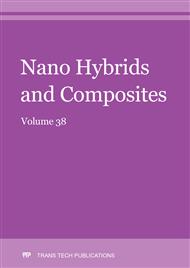[1]
S. Nayak, R.K. Nayak and et al., Effect of nanofillers on low-velocity impact properties of synthetic and natural fibre reinforced polymer composites- a review, Advances in Materials and Processing Technologies, (2021).
DOI: 10.1080/2374068X.2021.1945293
Google Scholar
[2]
Y. Huang, B. Karami, D. Shahsavari and A. Tounsi, Static stability analysis of carbon nanotube reinforced polymeric composite doubly curved micro‑shell panels, Archives of Civil and Mechanical Engineering, 21 (2021) 139.
DOI: 10.1007/s43452-021-00291-7
Google Scholar
[3]
R. Zerrouki, A. Karas, M. Zidour, A. A. Bousahla, A. Tounsi and et al, Effect of nonlinear FG-CNT distribution on mechanical properties of functionally graded nano composite beam, Structural Engineering and Mechanics, 78 ( 2) (2021) 117-124. DOI: org/10.12989/sem.2021.78.2.117.
Google Scholar
[4]
F. Heidari, K. Taheri, M. Sheybani, M.J. Janghorban and A. Tounsi, On the mechanics of nano composites reinforced by wavy/defected/aggregated nanotubes, Steel and Composite Structures, 38, (2021) 533-545. DOI:org/10.12989/scs.2021.38.5.533.
Google Scholar
[5]
E. Arshid, M. Khorasani, Z. Soleimani‑Javid, S. Amir, and A. Tounsi, Porosity-dependent vibration analysis of FG microplates embedded by polymeric nano composite patches considering hygrothermal effect via an innovative plate theory, Engineering with Computers, (2021). DOI:org/10.1007/s00366-021-01382-y.
DOI: 10.1007/s00366-021-01382-y
Google Scholar
[6]
M.S. and S.S. Kumar, Ballistic performance of synergistically toughened Kevlar/epoxy composite targets reinforced with multi-walled carbon nanotubes/graphene Nanofillers, Polymer Composıtes, 43 (2) (2022) 782-797.
DOI: 10.1002/pc.26409
Google Scholar
[7]
A.J. Varghese and A.A. Ronald, Low Velocity Impact, Fatigue and Visco-elastic Behaviour of Carbon/E-glass Intra-ply fibre-Reinforced Nanosilica Toughened Epoxy Composite, Silicon, 13 (5) (2020) 1655-1661.
DOI: 10.1007/s12633-020-00566-3
Google Scholar
[8]
P. Dharmavarapu and M.B.S.S Reddy, Mechanical, Low Velocity Impact, fatigue and Tribology Behaviour of Silane Grafted Aramid Fibre and Nanosilica Toughened Epoxy Composite, Silicon, 14(6), (2021) 1741-1750.
DOI: 10.1007/s12633-020-00567-2
Google Scholar
[9]
P.M. Ajayan, L.S. Schadler and P.V. Braun, Nano Composite Science and Technology, Wiley-VCH Press, Germany, (2003).
Google Scholar
[10]
P.H.C. Camargo, K.G. Satyanarayana and F. Wypych, Nano Composite: Synthesis, Structure, Properties and New Application Opportunities, Materials Research, 12 (1) (2009) 1-39, DOI: 10.1590 / S1516-14392009000100002.
DOI: 10.1590/s1516-14392009000100002
Google Scholar
[11]
A. Osman, A. Elhakeem et al, Influence of Different Nano Structured Filler on the Performance of Epoxy Nano Composites. Nano Hybrids and Composites, 6 (2020) 51–60.
DOI: 10.4028/www.scientific.net/nhc.29.51
Google Scholar
[12]
J. Cesar D. Santos, L.M. G. Vieira and et al, Impact Behaviour of Hybrid Carbon Fibre Composites Reinforced with Silica Micro-and Functionalized Nanoparticles, Nano Hybrids and Composites, 21 (2018) 1-9.
DOI: 10.4028/www.scientific.net/nhc.21.1
Google Scholar
[13]
N. K. Kamada, K.N.S. Suman and et al, Investigation on Mechanical, Thermal and Bonding Properties of MWCNTs Reinforced Aramid/Epoxy Composite, Nano Hybrids and Composites, 30 (2020) 27–40.
DOI: 10.4028/www.scientific.net/nhc.30.27
Google Scholar
[14]
H.B. Kaybal, H. Ulus, O. Demir and et al, Effects of Alumina Nanoparticles on Dynamic Impact Responses of Carbon Fibre Reinforced Epoxy Matrix Nano Composites. Engineering Science and Technology, an International Journal, 21(3) (2018) 399-407.
DOI: 10.1016/j.jestch.2018.03.011
Google Scholar
[15]
M.H. Meybodi, S.S. Samandari, M. Sadighi and M.R. Bagheri, Low Velocity Impact Response of a Nano Composite Beam Using an Analytical Model, Latin American Journal of Solids and Structures, 12 (2) (2015) 333-354.
DOI: 10.1590/1679-78251346
Google Scholar
[16]
T.H. Mahdi, E. Islam, M.V. Hosur and S. Jeelani, Low Velocity Impact Performance of Carbon Fibre Reinforced Plastics Modified with Carbon Nanotube, Nanoclay and Hybrid Nanoparticles. Journal of Reinforced Plastics and Composites, 36(9) (2017) 696-713.
DOI: 10.1177/0731684417693429
Google Scholar
[17]
A.C. Tatar, H.B. Kaybal, H. Ulus and et al., Evaluation of Low Velocity Impact Behaviour of Epoxy Nano Composite Laminates Modified with SiO2 Nanoparticles at Cryogenic Temperatures, Journal of Research on Engineering Structures and Materials, 5(2) (2019) 115-125. DOI 10.17515/resm2018.55is0704.
DOI: 10.17515/resm2018.55is0704
Google Scholar
[18]
E.M. Soliman, M.P. Sheyka and M.R. Taha, Low Velocity Impact of Thin Woven Carbon Fabric Composites Incorporating Multi Walled Carbon Nanotubes, International Journal of Impact Engineering, 47 (2012) 39-47.
DOI: 10.1016/j.ijimpeng.2012.03.002
Google Scholar
[19]
N. Tsartsaris, M. Meo and et al., Low Velocity Impact Behaviour of Fibre Metal Laminates. Journal of Composite Materials, 45(7) (2011) 803-814.
DOI: 10.1177/0021998310376108
Google Scholar
[20]
Z. Asaee, M. Mohamed, M., D.D. Cicco and F. Taheri, Low Velocity Impact Response and Damage Mechanism of 3D Fibre-Metal Laminates Reinforced with Amino-Functionalized Graphene Nano Platelets, International Journal of Composite Materials, 7(1) (2017) 20-36.
Google Scholar
[21]
S. Patil, D.M. Reddy and M. Reddy, Low Velocity Impact Analysis on Composite Structures. AIP Conference Proceedings, 1943 (1) (2018).
DOI: 10.1063/1.5029585
Google Scholar
[22]
J.L. Chen, S. Lee, J.S. Wu and F. Elaldi, Manufacture of Carbon Fibre Nano Based Epoxy Composite Laminates using a Vacuum-Assisted Resin Transfer Mould. Canadian International Conference on Composite Materials, 2017. CANCOM2017, Ottawa CANADA.
Google Scholar


